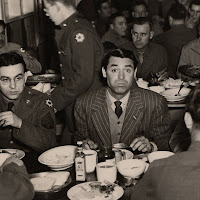I stuffed my camera back in my pocket. "Nah, probably not."



Several months ago, some friends and I were scouting the desolate remains of the U.S. Army's Fort Crowder near Neosho, Missouri, for possible use in organizing outdoor events. We had permission to be there from the current owner, Crowder College, but exploring the derelict military installation seemed like a clandestine operation. Not for public consumption, and definitely not for blogging.
As I discovered, the site's history is too interesting to keep to myself.
Camp Crowder



Camp Crowder started life as an Army Signal Corps training base built during World War II. At its peak, its operations expanded to roughly 45,000 people stationed across a sprawling city of soldiers, block after block of barracks and drilling grounds. Crowder's ranks saw everything from basic training to specialized communications instruction, and even Axis prisoners of war.

Postcard from Flickr user "Smaddy."



Colorful visitors: Senator Harry Truman (born in nearby Lamar, MO), Cary Grant, and Congressman and necktie enthusiast Dewey Short. Images courtesy of the Missouri State Archives.

Swastikas marking the funeral of a German captive. Images courtesy of the Missouri State Archives.
Links ahoy:
[Missouri State Archives: Camp Crowder Photograph Collection]
[Newton County History]
[Camp Crowder postcard history]
Camp Swampy

Cartoonist Mort Walker, creator of comic strip Beetle Bailey and its spin-off television shorts, was stationed at Crowder during the Big One. When the comic strip began in 1950, Walker had no want for material - gags follow the toils and characters of base life.


No coincidences: Camp Swampy is Camp Crowder.
Among today's old, weathered stop signs and concrete footings was the ever-aloof Private Bailey, getting his neck wrung by the Sarge for napping against a half-painted door. We've seen how the L'il Abner comic was a uniquely Ozarkian endeavor, spawning its own "Dogpatch U.S.A." theme park near Jasper, Arkansas. Here is another real-life standard straight out of the Sunday funny pages.



Inspiring decades of worked shrugged by Private Bailey. Images courtesy of the Missouri State Archives.

Neither gender or racial sensitivity was up to modern norms, but look, there was a war on.
Rubber band gun from Volume 22.
Crowder's role diminished after the war, briefly becoming a rocket testing ground before dividing the land among Crowder College, the National Guard, and local industry. Most of the infrastructure was sold or demolished, but the more permanent works in asphalt and concrete remain. A web personal favorite of mine, Underground Ozarks, has some pictures of areas we were not able to cover.



Among the relics: a rusty desk, oil drums, and concrete blocks marked with weights of odd accuracy.



Touring the old base, the one thing that stands out is the remarkable pace of nature. Constructions erected with even military efficiency are no match for the Ozarks' relentless green tide. Trees grow in the middle of old roads, and herds of white-tailed deer roam the fields where neat rows of buildings once stood. Any low spot in the soil became fair game for a frog pond.



General Halftrack is long gone from Camp Crowder, and the past has faded rapidly. Like Beetle Bailey, Mother Nature is not one to take orders.





